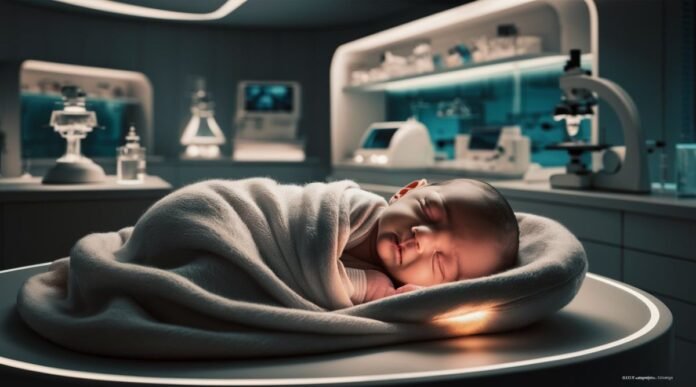What if having a baby was more like choosing from a menu instead of leaving it to chance?
Lab-grown sperm and eggs, which used to be a concept in science fiction, are now real in science. Scientists can use in-vitro gametogenesis (IVG) to change regular skin cells into sperm or eggs. This could mean the end of infertility. Couples could have biological children. Even solo reproduction could become possible. But that’s just the beginning.
If we can create eggs and sperm in a lab, what keeps us from changing them? Improving intelligence? Improving sports skills? Choosing the “best” genes? The jump from treating illnesses to making custom kids is very small.
Science is progressing quickly. Are we prepared for what is coming next?
The Science of In-Vitro Gametogenesis (IVG):
Science is getting dangerously close to rewriting the rules of reproduction.
In in-vitro gametogenesis (IVG), studies have showed that scientists can take a regular skin or blood cell, revert it to an early developmental stage, and then guide it to become sperm or an egg. No need for normal ways of having babies. There’s no need for a cellular clock. Just a lab, some drugs, and a bit of genetic magic.
It’s already worked in mice. In 2016, Japanese scientists turned skin cells into fully functional eggs, fertilized them, and produced live, healthy offspring. The same team later did it with sperm. Humans? Not quite there yet. But early-stage sperm and egg cells have already been lab-grown. It’s only a matter of time.
The implications? Huge. Infertility could become a thing of the past. Same-sex couples could have biological children. Even solo reproduction—using just one person’s cells to create both sperm and egg—could be possible.
But there’s a catch. Actually, several.
Would these lab-made gametes function like the real thing? What if tiny mutations slip through, leading to unforeseen defects? And if we can make eggs and sperm from scratch, what’s stopping us from “optimizing” them?
The science is moving fast. The ethics? Still trying to catch up.
Potential Applications:
If IVG happens, it could change reproduction completely.

Infertility, Gone for Good?
No more difficulties with IVF. No more depending on sperm or egg sources. Infertility might become a thing of the past.
Doctors can take one skin cell, change it, and make a sperm or egg that is designed for the patient. People who lost their ability to have children because of cancer treatments, age, or genetics may have another opportunity.
Same-Sex Reproduction Becomes Possible:
Two men having a biological child? Two women? With IVG, this could become routine.
One partner’s skin cell could be turned into an egg, the other provides sperm. No donors. No “half-biological” children. The baby would be 100% theirs, genetically speaking.
Solo Parenting, No Partner Required:
Here’s where things get really strange.
In theory, a single person could provide both sperm and egg. The result? A child with only one genetic parent.
Would society accept this? Would there be unknown health risks from extreme inbreeding? No one knows yet. But if the technology works, some people will try it.
The Death of the Biological Clock:
Forget egg freezing. Forget “running out of time.”
With IVG, eggs and sperm could be created on demand, at any age. Want to have kids in your 50s? Your 70s? Maybe even later? Science says: why not?
It’s an entirely new era of human reproduction. But are we ready for it?
From Fertility Treatment to Designer Babies:
Assisting people in having children is one thing. Customizing them? That’s a completely different situation.
After they figure out how to cultivate sperm and eggs in a lab, scientists won’t be limited to choosing the healthiest ones. They can change them.
The Temptation to Optimize:
At first, the goal will be medical. Screening embryos for genetic diseases. Preventing conditions like cystic fibrosis or Huntington’s. Maybe even tweaking genes to lower the risk of cancer.
But once that door is open, it won’t close easily.
If parents could guarantee their child was taller, naturally athletic, or highly intelligent—would they? And if they don’t, what happens when others do?
A New Kind of Inequality:
We already live in a world where money buys better healthcare, education, and opportunities. What happens when it buys better genes?
If only the wealthy can afford enhancements, we could see a genetic class divide emerge. Over generations, the gap could grow. Natural-born humans on one side. The genetically optimized elite on the other.
The Risk of Genetic Uniformity:
Nature operates in unpredictable ways. Mutations, variations, and what we call “imperfections” help evolution progress. What happens if people start getting rid of everything they don’t like?
What happens if everyone chooses the same traits, like being tall, smart, or athletic? What would happen if innovation, neurodiversity, or small physical differences were to vanish?
We could end up with a world that’s more optimized, but far less diverse. And maybe, in the long run, more fragile.
Ethical Dilemmas:
The line between helping and controlling human life is razor-thin. With IVG technology, it could blur beyond recognition.
The Ethics of Genetic Editing:
We can now change the basic nature of human life. With great power also comes greater duty.
Genetic editing can be beneficial. Parents can stop serious, life-threatening diseases before they start. What happens when that power can change things like how someone looks, how smart they are, or how well they handle their emotions?
The “Designer Baby” Debate:
The phrase “designer babies” sounds like something from a sci-fi dystopia. And yet, it’s quickly becoming a real possibility. Imagine choosing your child’s eye color, intelligence, or athleticism the same way you pick a flavor at an ice cream shop.
It feels like we’ve crossed into uncharted moral waters. The question is: Should we even have that power?
What happens when parents select traits—say, the perfect body, the perfect mind? Will that child ever feel like they belong to themselves, or would they always live in the shadow of their parents’ dreams?
Autonomy vs. Parental Control:
Parents already shape their children’s futures—through education, environment, and upbringing. But when it comes to their child’s genetic makeup, is it still their decision to make?
In a world where genetic choices are possible, parents may feel empowered to ensure their child has the best chances at life. But what about the child’s right to form their own identity?
The real challenge will be finding a balance. How do we weigh parental control against a child’s autonomy? Should we even try to?

The Potential Pitfalls:
IVG technology holds the promise of a brighter, genetically tailored future. But as with any cutting-edge innovation, the road ahead is uncertain—and fraught with potential risks.
Unintended Consequences:
It’s tempting to imagine all the ways IVG could improve human life. Eradicating genetic diseases. Enhancing desirable traits. The possibilities seem endless. But here’s the catch: unintended consequences.
Throughout history, we’ve seen how technological advancements can lead to outcomes we didn’t predict. Think of the internet. Initially designed to connect people, it has also brought about privacy invasions, cyberbullying, and misinformation. Could genetic engineering face similar risks?
Even with the best intentions, how can we ensure we won’t create new problems—health issues, societal inequalities, or even environmental impacts? The road to perfection may have hidden traps we’re not yet aware of.
The Risk of Narrowing Diversity:
One of humanity’s greatest strengths has always been its diversity—in ideas, skills, backgrounds, and even physical traits. It’s this diversity that fuels creativity, innovation, and evolution.
But what if IVG technology leads to a future where everyone is genetically similar? Sure, we could eliminate disease, but at what cost? We might be creating people designed for a world of narrow standards.
A society where everyone is optimized for the same goals—same intelligence, same abilities, same health—could leave little room for the kind of individuality that has always driven human progress. Could a lack of genetic diversity lead to a loss of cultural diversity as well?
A Brave New World?
So, what happens if we reach the ultimate goal of a genetic utopia? Think of a world where no one suffers from genetic diseases, where every child is born with the “best” traits possible.
But is that a utopia—or something far more troubling? What if in our pursuit of perfection, we create a world where everyone is the same?
We may find ourselves in a world where uniqueness is lost, where individual expression is overshadowed by the pressure to conform to genetically predetermined standards. And that might be a dystopia, not a utopia.
The more we try to control, the more we risk creating a society devoid of the very things that make us human.
Regulation and Access:
As IVG technology advances, a pressing question arises: who controls its use? The stakes are high—this is a political, ethical, and scientific issue all rolled into one.
The Need for Regulation:
IVG could drastically alter human biology, but without proper regulation, the risks are huge. Think about it: what if only the rich can afford genetic enhancements, leaving the rest behind?
We’ve seen this before—unregulated technologies can be abused. Governments and scientists must collaborate to control how this power is used. We need oversight, and it must be fair.
Who Gets to Choose?
Right now, society has its ideas of what’s “good”—health, beauty, intelligence. But with IVG, those decisions could be in the hands of scientists, corporations, or governments.
Who decides what makes someone “perfect”? Will these choices be based on profit or cultural standards? If we’re not careful, we could open the door to a society where certain traits are considered superior, leaving others behind.
Access and Inequality:
Access to IVG will likely be expensive. Consider a world where only the wealthy can afford to genetically enhance their children, while the poor have no options. The gap between social classes could widen even further.
A system like this could lead to genetic inequality, where only the elite get the benefits of cutting-edge science. That’s a future we shouldn’t allow to happen.
Global Implications:
IVG could have global ramifications. Different countries have different cultural views on ethics—how can we ensure that IVG is used responsibly worldwide?
A global framework for regulating IVG is crucial. Without international collaboration, we could face chaos. The world will need to come together to decide how this powerful technology is handled—or risk creating even bigger divides.
In a Nutshell:
The future of IVG is both thrilling and unsettling. The potential to design life itself promises new opportunities but also brings unpredictable risks. As we stand on the edge of a new era in human reproduction, the decisions we make today will echo far into the future.
Ultimately, balance is key. We must proceed with caution, ensuring that ethics and equity guide our approach. The ability to shape our future children should not come at the cost of our humanity. It’s time to ask: Are we ready for this power?


